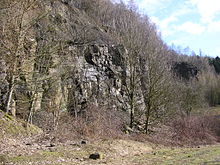Porta sandstone
The porta sandstone (also brown stone ) occurs between Lübbecke , Minden and Lemgo in East Westphalia . It is a carbonate - ferritic sandstone between the Weser Uplands and the Wiehen Mountains . It originated in the Middle Jurassic in the macrocephalic layers .
Rock description and occurrence
Porta sandstone is blue-gray, yellowish and gray-greenish to brown when fresh. It shows some rusty stains that are due to its iron content. It is coarse-grained with a grain size of around 1 mm. The grain is bound quartzite and kaolin .
At the Weser breakthrough at Porta Westfalica , the sandstone bank is up to 20 meters thick. About 4 to 5 kilometers west of the breakthrough, the thickness decreases to 10 meters and east of Lübbecke to 4 to 8 meters, and finally wedges out completely at Lübbecke (gradual reduction in thickness to 0 m). This sandstone is weather resistant to different degrees.
Use and dismantling
Porta sandstone has been used as natural stone since the 11th century along the Weser in Minden , Verden (Aller) , Bremen and Nienburg / Weser . Examples are Petershagen Castle , Minden Cathedral , the Romanesque church of St. Cosmae et Damiani in Dörverden , Minden train station (Westphalia) and many other buildings. It was mined either in the form of stairs or - especially on the right bank of the Weser - in tunnels that were expanded for the armaments industry during the Second World War . After the war ended they were blown up. As early as 1938, the porta sandstone was only being mined in a small business with six employees. After the Second World War, this natural stone was no longer mined.
Abandoned quarries:
- Training area for the Pioneer Regiment 100 and Blue Lake near Porta Westfalica ⊙
- Sandstone cliff at the Porta-Kanzel due to the expansion of the traffic routes, the ore mining and the U-relocations ⊙
- Porta Westfalica (Goethe open-air theater) ⊙
- Wolfsschlucht (Porta Westfalica) , one of the oldest sandstone quarries with numerous tunnel entrances ⊙
- Oberlübber Bergsee , open pit lake ⊙
- at Lübbecke ⊙
See also
- List of buildings made of porta sandstone
- Obernkirchen sandstone
- Osning sandstone
- Ibbenbürener sandstone
literature
- Otto Sickenberg: stones and earth. The deposits and their management. Geology and Deposits in Lower Saxony , 5th vol. Bremen 1951, p. 177 ff.
- Rainer Ebel and Angela Ehling: The Porta Sandstone. Geology, occurrence, historical mining and use . In: Regional Association Westphalia-Lippe. Geology and paleontology in Westphalia. tape 82 . Münster 2012, ISBN 978-3-940726-18-6 .

